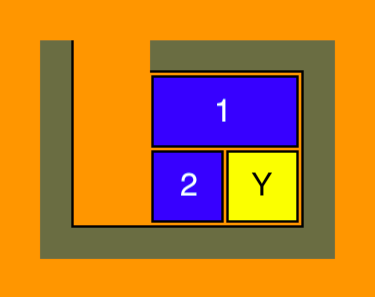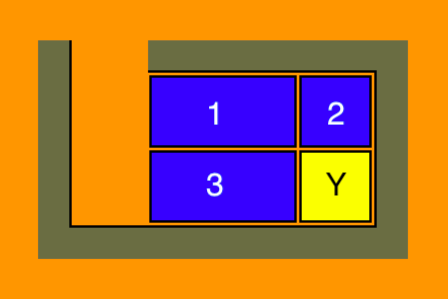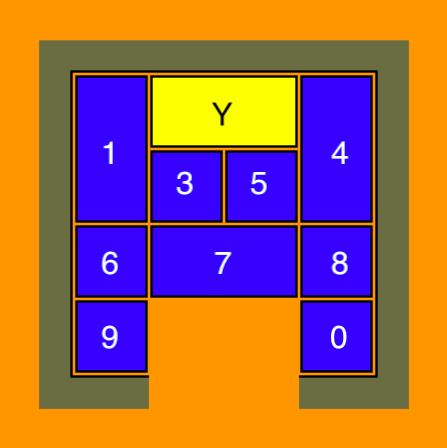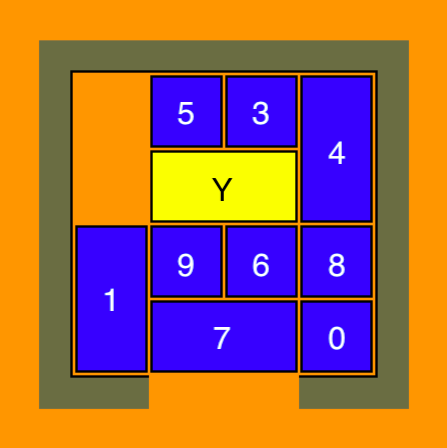Sliding Blocks ©©
Total number of plays: 443254
Total number of wins: 326284
Total number of wins: 326284
How To Play
- To win, move the yellow block to the exit.
- To move a block, click and drag it, or click the block then click on the empty space.
- Grey blocks cannot be moved.
Puzzles shown on this page are created and owned by Caribou Contests ©
Editor Instructions
- Use the width and height labels to change the size of your board.
- Select a colour below the board to choose what colour block you wish to put on the board.
- Click on the board to place a single block of that colour.
- Click and drag on the board to enlarge the size of a block.
- Click the 'Clear Board' button to clear your board and start over.
- Click 'Generate Random Board' to randomly create a puzzle to edit.
- Click the 'Play Your Puzzle' button when you wish to play your board.
- Click 'Discard Your Puzzle' to cancel editing and return to the normal game.
Moves made: 0
Width: Height:
Difficulty: Easy Medium Hard Very Hard Famous
SlowFast
You get the most out of the activities by first thinking for a while before expanding the answers to the questions.
Have fun.
- The Sokoban game is similar to Sliding Blocks for several reasons.
-
- In both games:
-
- Something has to be moved around, and the problem is a lack of empty space.
- Solution sequences may be long.
- The search tree is narrow. What that means is that if one makes random moves without a plan then one soon gets back to a position that one has encountered before. This makes these puzzles much easier than, for example, a Rubik's Cube, where random moves will basically never take you back to the starting position.
- It is useful to formulate intermediate goals. More about that further below.
- To modify a problem one can click 'Create a Puzzle'. A puzzle becomes easier if blocks are replaced by empty space, or if larger blocks are split into smaller blocks occupying the same space, or if fixed grey blocks are changed into blue blocks to become movable. Equally, a puzzle becomes harder if empty space becomes occupied by a new block, or if small blocks are merged into bigger ones, or a blue block is changed into a grey block.
 When watching animated solutions of puzzles, can you observe a general principle that these solutions have in common which might be a good hint for your own solution attempts?
When watching animated solutions of puzzles, can you observe a general principle that these solutions have in common which might be a good hint for your own solution attempts?
- One hint is given next.
 When it becomes harder to turn a key in a lock, or when the chain of your bicycle becomes stiff, what do you do?
When it becomes harder to turn a key in a lock, or when the chain of your bicycle becomes stiff, what do you do?
- You can apply oil or grease to reduce friction.
 In Sliding Blocks we also want to move blocks around and seem to encounter some kind of friction. Is there similar help here?
In Sliding Blocks we also want to move blocks around and seem to encounter some kind of friction. Is there similar help here?
- The role of grease is played here by small blocks. It is a good idea to have 2 or sometimes 3 small blocks in between two larger blocks, especially around the yellow block which needs to be moved most. Here is the justification.
- Let us assume that the yellow block is two small squares wide and needs to be moved downwards.
- Then before the move there must be two empty spaces underneath the block, and after the move there will be two empty spaces where the block used to be. Then the two empty spaces above the yellow block need to move again around the yellow block so that this block can move further. To move the two spaces around the yellow block, the surrounding blocks need to be movable. Small blocks are easier to move than bigger ones, for example, around corners. Therefore it is a good idea to have groups of 2 and sometimes 3 small blocks between larger blocks, especially around the yellow block which needs to move most.
- Have a look at solutions of hard problems and check how often the above recommendation applies.
 To find long solution sequences it is useful to think in terms of short sequences like building blocks out of which longer sequences are composed. One typical task of such a short sequence is to rotate blocks in a circle. Can you think how that is done?
To find long solution sequences it is useful to think in terms of short sequences like building blocks out of which longer sequences are composed. One typical task of such a short sequence is to rotate blocks in a circle. Can you think how that is done?
- As an example, consider the following position:

- The blocks 1, 2 and Y, and two free spaces can be moved around in a circle, and thus the block 1 or the two free spaces can be placed wherever they are needed.
- The next position has two larger blocks 1 and 3, but also more space:

- Here all blocks can be moved in a circle as well, which allows us to position the blocks 1, 3 and the empty space wherever they are needed.
- Both circular motions will be needed in an example described further below.
- Strictly speaking, yes. But in science it is good to be flexible and inventive. How about considering empty spaces also as blocks which have the special ability that they can swap places with neighbouring blocks? For example, in solid state physics, missing electrons in a grid of atoms leave a gap and such a gap moves like a real particle just with opposite charge. Thinking this way makes it easier to explain, for example, how a transistor works.
- In our game the two circular motions of blocks mentioned in the previous item can also be seen as circular motion of the two empty spaces in the opposite direction.
 If Sokoban and Sliding Blocks are similar, then which solving strategies of Sokoban can be used in Sliding Blocks?
If Sokoban and Sliding Blocks are similar, then which solving strategies of Sokoban can be used in Sliding Blocks?
- Because in both games the search tree is narrow, it is possible in both games to break up the whole solution into intermediate goals. For example, consider the following puzzle:

- The yellow wide block Y must pass the wide block 7 in order to get out. How should that be possible? For Y to move downwards we need small blocks around Y so that after moving Y the first time the empty space above Y can be moved below Y so that Y can be moved down further. Therefore two small blocks should be brought between Y and either block 1 or block 4, and then free space needs to be made underneath Y. Y is then moved downwards and the 2 small blocks should be moved to the new free space above Y.
- Before all of that, 1 or 4 must therefore be moved downwards. Let's go with 1. To move 1 down, the blocks 6 and 9 must be moved out of the way. According to our earlier hint to have small blocks close to the yellow block, we should start by moving 7 down, 6 and 9 into the new free space above 7 and then move 1 down and now rotate Y and 3 and 5 in a circle as described earlier so that Y and 3,5 swap places. After all of this we should have the resulting position:

- Now we can either move 1 up, or we can move 5,3 and Y to the left, and move other blocks up on the right. Because it is always harder to pass larger blocks along each other, we should take the opportunity to move 1 up. What is left to do is to get 9,6 to the left to move Y down, to move 3 underneath 5, and 4 to the left to get 8,0 up. Now the 'building block rotation' described above is used to get Y above the exit. The puzzle is solved.
- As a general strategy, start from the final goal of getting the yellow block out and then go backwards and formulate necessary sub-, sub-sub-,... goals which together will reveal the whole solution.
- Move big blocks out of the way, preferably into a corner far away from the exit.
- It is often easy to see that some blocks are too big to pass each other. By being aware of such limitations of movement, one can avoid guessing and avoid fruitless attempts and better formulate sub goals.
- To keep moving a bigger block, empty spaces need to be created before the block, then the block is moved which results in empty spaces behind the block. These resulting empty spaces need to be 'moved' to the front of the big block to move the big block further. For all of that movement small blocks are needed before and behind big blocks. So the first sequence of moves may just aim at putting the small blocks where they are needed later, around bigger blocks.
- To move a big block, there needs to be space in the direction it is to be moved. For example, if the block has a width of 2 in one direction but the whole puzzle has only one free space then that block will never be moved in this direction but may be movable in a direction perpendicular to that where it is more slim. Similarly, if a puzzle has only 2 free spaces and a block has a width of 3 then this block will never be moved in the perpendicular direction of that width because for that 3 free spaces would be needed. But the block may be movable in the other direction. Again, knowing limited moveability makes it easier to find a solution by being aware in which direction each bigger block can only be moved and thinking of only such moves.
- It is useful to 'see' circles where one or two empty spaces are moved in a circle together with all the boxes in the circle. Such a circle can have the shape of a rectangle. Moving everything (free spaces and boxes) in the circle does not touch any other blocks outside the circle and may seem pointless. But the side effect of bringing small blocks to a certain position in the circle may be crucial later. An example would be a place close to a big block to fill up empty spaces after this block is moved. Thinking in terms of move sequences like circles instead of single moves allows one to think deeper.
- A recommended learning strategy is to start with easy puzzles and to increase the difficulty level slowly. If one can not solve a puzzle then one watches the animated solution in slow motion, finds the move one missed, thinks of the purpose of that move by watching the next moves, and of how one could have seen this purpose.





Follow or subscribe for updates: